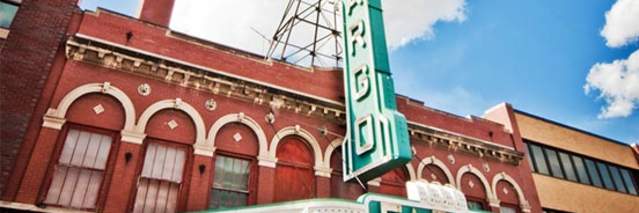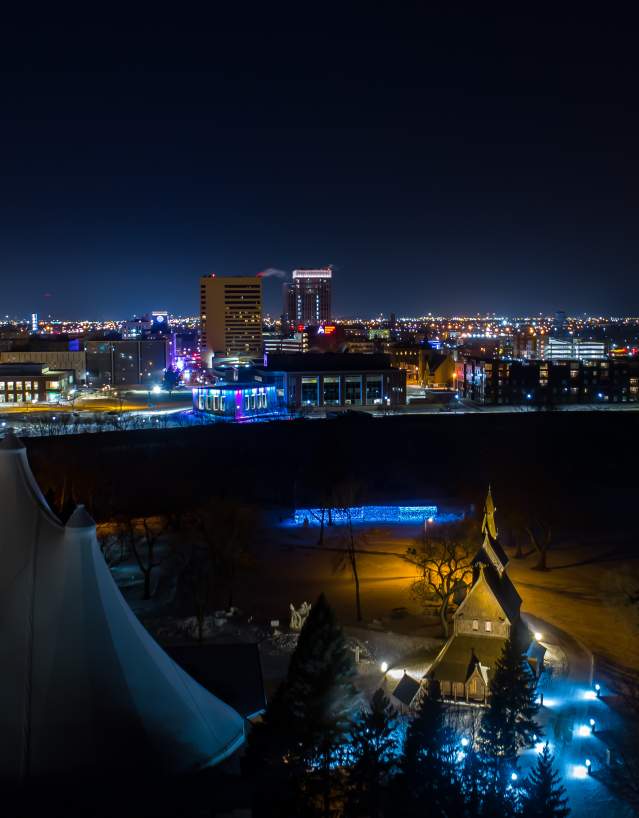The Tourism Industry in Fargo
The staff at Visit Fargo-Moorhead is dedicated to helping local partners grow their businesses and advance their capital projects, which helps with recruitment, retention, and the overall happiness of the Fargo-Moorhead-West Fargo community.
You may have heard about the Visit Fargo-Moorhead and pass by the grain elevator Visitors Center now and then, but what are we truly doing to help push projects forward? How are we advocating for visitor-focused businesses to thrive and succeed?
Here are some of the main things our staff is focused on, as well as some information on how to request grants and get involved in Visit Fargo-Moorhead's work.
Mission Statement
Visit Fargo-Moorhead works to position our distinctive community as a desirable destination and gateway to the region and nation, resulting in a superior quality of life for its residents.
Vision Statement
Visit Fargo-Moorhead will be the respected authority on Tourism as an Economic Development strategy that enhances the region’s quality of life.
Visit Fargo-Moorhead will collaboratively develop and promote a shared community vision to enhance the region’s attractiveness for visitors and residents alike.
Capital Construction Grants
The Fargo-Moorhead Convention & Visitors Bureau Board of Directors manages a Capital Grant Program, funded by one-third (1 penny on the dollar) of the lodging tax levied in Fargo and West Fargo. The entire three percent lodging tax from Moorhead goes to our operating budget, but Moorhead entities can apply for grants. The goal of the grants is to help with destination development throughout the Fargo-Moorhead-West Fargo region.
The Board will consider grant requests for projects involving costs related to capital construction that will have a demonstrable and positive effect on the community’s economy. Any such projects must be in an area directly related to tourism.
Event Assistance Grants
The FM CVB also provides dollars to help enhance or start events in the community. Previous recipients of these grants and sponsorships include Fargo-Moorhead PRIDE, the Downtown Street Fair, Frostival, the Fargo-Moorhead Studio Crawl, and many more throughout the FM CVB’s fiscal year.
Event Impact on Tourism & Visitor Spending
Historical Event Impacts
The Fargo Dome Authority and Visit Fargo-Moorhead commissioned a study to examine the economic effects of local events on the FM area economy. The 2019 study was based on the premise that spending associated with events & activities around our communities, including at FARGODOME, contributes to the economic base, increasing the demand for goods and services in several economic sectors, enhancing local employment opportunities, and augmenting local tax revenues.
Spending by event attendees for various types of events (e.g., concerts, family entertainment, sporting events, trade shows, and so on) was hypothesized to have different characteristics and event-related expenditures. Accordingly, events were grouped into 10 categories, and a representative sample of events for each category was identified. Event attendees and/or participants were surveyed, providing robust and defensible estimates of attendees’ characteristics and expenditures. The survey also collected information to differentiate between the direct economic impact of an event (the net increase in regional expenditures directly related to the event) and the total spending of all event visitors and participants. Nearly 5,500 completed questionnaires were obtained from attendees at the various events surveyed.
Event attendee residence and expenditures, obtained from the surveys, were combined with attendance records provided by the event planners to estimate direct economic impacts from event attendance and participation. Secondary economic effects were estimated using input-output analysis, a common and widely accepted framework used in economic impact and economic contribution studies, which estimates how changes in industry and household activities affect an economy. Economic effects related to the community were described as changes in economic output (sales), employment, labor income, and tax revenues.
Read the full Participant Visitor Spending Report below for insight on past event impacts.
Convention Center
The Fargo-Moorhead-West Fargo community desperately needs more meeting space and a traditional convention center to compete against similarly sized (and smaller) regional cities. While there are larger spaces, the other issue includes securing conference dates. Spaces like the FARGODOME are nearly impossible to book since it is the only space in town that can accommodate events so they tend to be booked up early and often.
Current Convention spaces in Fargo-Moorhead-West Fargo:
| FARGODOME | 80,000 square foot arena floor 10,268 ballroom (dividable) 3,160 additional meeting space |
| Holiday Inn | 27,000 square feet total 11,000 square feet ballroom (dividable) 19 total meeting rooms |
| Delta Hotels by Marriott | 23,000 square feet total 15,000 square feet ballroom (dividable) 13 total meeting rooms |
| Avalon Event Center | 15,350 square feet total 6,000 square feet ballroom 6 total meeting rooms |
| Hilton Garden Inn | 15,000 square feet total 10,000 square feet ballroom 7 total meeting rooms |
Largest Convention Space in Competitive Destinations:
| Bismarck Civic Center | 100,000 square foot exhibit hall (dividable) 16 additional meeting rooms 10,000-seat arena (40,000 square foot floor) |
| Grand Foks Alerus Center |
80,000-square-foot arena |
| Sioux Falls Convention Center | 50,000 square foot ballroom (dividable) 10,110 square foot additional meeting room space |
| St. Cloud River’s Edge Convention Center | 150,000 total square foot 19 additional meeting rooms 16,000 square foot ballroom 60,000-square-foot exhibit space |
| Duluth DECC | Cityside: 26,000 square foot ballroom 9 meeting additional rooms 15,000 square foot exhibit hall Pioneer Hall: 48,250 square foot |
| Rochester Mayo Civic Center | 38,586 square foot ballroom (dividable) 25,000 square foot exhibit hall (dividable) 15,810 square foot auditorium 25,000-square-foot arena |
| Mankato Verizon Center |
21,100 square foot event center |
Conventions we’re currently unable to accommodate:
Over the years, Visit Fargo Moorhead has collected a list of lost businesses because of the lack of traditional meeting space. This list continues to grow, and these conferences will continue to move to compete markets until this is rectified.
Unable to Accommodate:
| Convention | Attendees | Potential Direct Visitor Spending |
| Western Interstate Child Support Enforcement Council Annual Training | 550 attendees | approx. $970k |
| Blue Cross Blue Shield Association | 1,500 attendees | |
| ND United | 5,000 attendees | |
| Williston Basin Petroleum Conference | 5,000 attendees | approx. $1.6 M |
| YMCA of the USA | 5,000 attendees |
Conventions Who Have Outgrown Their Space:
| Convention | Attendees | Requirements |
| Education Theatre Association | 2,000 attendees | |
| ND Grocers Association Annual Meeting | 300 attendees | Need 12,000 sq ft exhibit + 10,000 sq ft banquet |
| ND Long-Term Care Spring Conference | 900 attendees | |
| ND Safety Council | 1,300 attendees | General session area, 218 booths, 11 breakout rooms (80-160 in each) and an area for safety demos. Lost to Bismarck Civic Center |
| Tri-State Aerial Applicators | 500 attendees | 450 room nights, 50 exhibit booths, 8 breakouts |
Conventions we could lose without more space:
| Organization/Event | Attendees | Current Location | Direct Visitor Spending |
| ND Long-Term Care Fall Conference | 500 attendees | Delta Hotel | |
| ND Soybean Conference | 600 attendees | Holiday Inn | |
| NDGOP | 2,000 attendees | Scheels Arena | |
| Jehovah’s Witnesses | 4,600 attendees | Scheels Arena | |
| ND Petroleum Council | 600 attendees | Delta |
Why should you care?
The direct visitor spending would be $400,000-$500,000 on average for a conference that might move over to a convention center; knowing the event will likely grow to be larger and double in direct visitor spending, you could expect something closer to $1.3 – 1.5 million per event.
The Fargo-Moorhead-West Fargo metro area is missing out on millions of dollars in annual visitor spending due to its lack of significant meeting space. Visitors of all kinds (leisure, business, meetings, and sports) greatly contribute to the local economy. In 2022, hotel room nights alone in this metro area accounted for more than $130 million in spending. All of those visitors also spent millions more on shopping, food & beverage, gas, and entertainment.
The tables above list medium to large conferences and conventions that would have come to FMWF, or given it serious consideration, if we had a large enough space to accommodate them. Also on that list are several events that have been coming here but have outgrown, or are about to outgrow, the facilities we currently have. One cold, hard example: the North Dakota Association of Counties has resisted bringing its annual convention to Fargo, the largest city in the state because it can’t find what it deems adequate space.
Those of us who live here often sell our community short as a place to visit, but those of us tasked with attracting visitors know this: people like to come here. We have multiple vibrant entertainments and shopping districts, and visitor amenities rival those of much larger communities. It’s easier to get here than many people think, and the community is visitor friendly in the most essential way, including ease of navigation. We know that building a true convention space will lead to significant growth in the already robust visitor economy here. And we hope the citizens of Fargo will join us in supporting a project to build true convention space.
Performing Arts Center
Background
The CVB is an active Performing Arts Task Force member working towards building a state-of-the-art performing arts center in Downtown Fargo. The task force has conducted multiple feasibility studies to determine whether or not a performing arts center is needed in the community.
During these studies, the current location of the Civic Center in Downtown Fargo was selected as the preferred site for the future home of the Performing Arts Center.
Why should you care?
The presence of performing arts opportunities in a community directly affects the individual residents and the quality of the community as a whole. A thriving performing arts culture increases the propensity of residents to participate in the arts, which in turn increases the community’s attractiveness to tourists, businesses, people, and investment.
What to expect
A 2015 feasibility study demonstrated that a performing arts center in Fargo would be successful and embraced by the public. The study was updated in 2018, and a task force renewed efforts on the project at that time, further studying potential facility sites and building programs.
Funding for the project, which would replace the Fargo Civic Auditorium adjacent to City Hall, would be a combination of the City of Fargo and donated dollars. In 2019, the City engaged a consulting firm to perform a feasibility study on the potential for philanthropic support for the project, the results of which showed positive interest in such a project.
Discussions have continued with an eye toward bringing a proposal forward to the public sometime in 2024 or later. The goal is to develop a facility that will be acoustically desirable for local and touring groups alike and have the appropriate amount of seating to accommodate community groups and touring shows.


